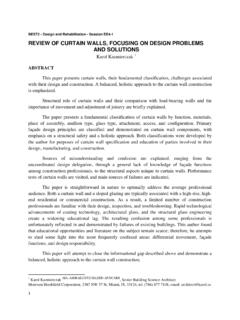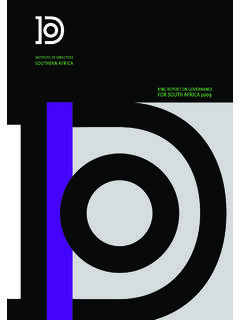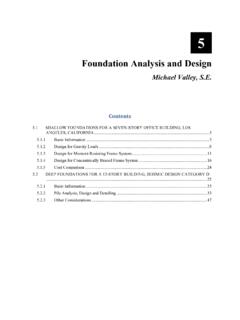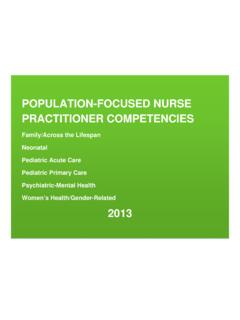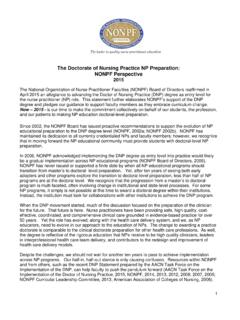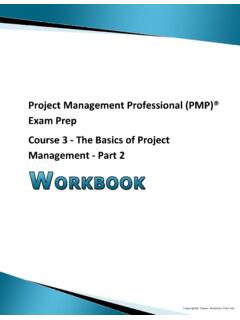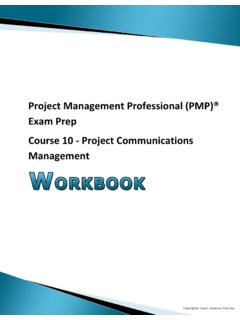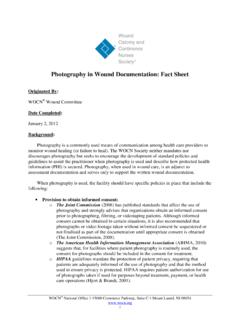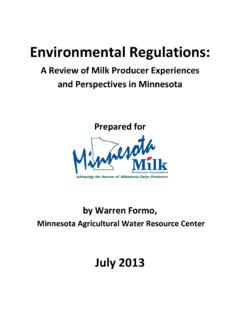Transcription of BOD/CBOD: Options, Tips& Tricks, and Upcoming Method …
1 BOD/CBOD: Options, Tips& Tricks and Upcoming Method Changes presented by: Christina Baker, chesterfield county Wastewater; Robin Parnell and Kerri Williams, Hampton Roads Sanitation District 1 2 Any reference to product or company names does not constitute endorsement by chesterfield county or HRSD. Tell us about you! Write on a sticky note: Municipality/Laboratory affiliation Most problematic concern with the analysis 3 Workshop Goals Present examples of different ways laboratories can meet the requirements of Standard Methods for the Examination of Water and Wastewater 22nd Edition, section 5210B (2011) for biochemical oxygen demand/ carbonaceous biochemical oxygen demand (BOD/CBOD).
2 Discuss questions and concerns regarding BOD/CBOD analyses. Discuss Upcoming changes to SM5210B. 4 Purpose of BOD/CBOD Analysis Determine how organic matter affects the concentration of dissolved oxygen (DO) in a stream or lake is integral to water-quality management. Environmental laboratories conduct BOD/CBOD testing for the purpose of: Process control for treatment of wastewater Reporting data for compliance with permits such as VPDES Monitor/regulate industrial users Used as an indication of the pollutant removal from wastewater. Represents the amount of oxygen consumed by bacteria and other microorganisms while they decompose organic matter under aerobic conditions at a specified temperature.
3 5 Laboratory Analysis/ Reporting Requirements Analyze wastewater samples for the purpose of reporting compliance data-must be VELAP certified or accredited for BOD/CBOD in non-potable water. Implement QC requirements stated in Chapter 45/46 or TNI 2009, and the QC requirements stated in SM5210B-2011. This includes blanks, glucose glutamic acid (GGA), and matrix duplicate samples. Meet VPDES permit requirements such as the BOD or CBOD Quantification Level (usually defined as 2 mg/L or 5 mg/L). Report data as specified in the VPDES permit, such as using at least the same number of significant digits as the permit limit.
4 6 Analysis Limitations Analysis is not easy: One time shot: 48 hr holding time-5 day analysis Demands consistency Years of experience Takes too long: Not a great measure for process control After 5 days hard to troubleshoot problems Accuracy is difficult to measure: The GGA standard is at a target concentration of 198 mg/L, while most final effluents range 2-45 mg/L Blank contamination: Difficult to pinpoint; so many moving pieces to the puzzle 7 Why Not Replace With COD and TOC ? 8 COD- Chemical oxygen demand is a measure of oxidizable organic and inorganic material TOC-Total organic carbon is a measure of organic carbon Not an exact replacement for BOD/CBOD Can find trends in BOD/CBOD/COD/TOC of a specific sample using multiple data points over a period of time No other test provides a better assessment of bioavailability of a waste stream How To Make BOD/CBOD Work For You Equipment Reagents Dilution water Seed Analysis technique 9 Equipment- Introduction DO meter Analog or digital.
5 Must be suitable for the selected probe DO probe Polarographic or galvanic membrane Optical (also referred to as luminescent) Air incubator (or water bath), 20 1 C, excluding all light BOD bottles, stoppers, caps pH meter Chlorine meter/ test strips/ titration equipment Thermometer(s) Carrying racks for BOD bottles Micropipettors and/or pipettes Analytical Balance Robotic instrument 10 DO Probe Types Images from 11 DO probe/ Meter Use Calibrate right before use (and document) Most labs calibrate in air May also calibrate in air-saturated water or by using Winkler titration May or may not have a built-in sensor to adjust for barometric pressure To ensure that the calibration is still good, blot the probe, allow to stabilize, and check to see that calibration value (100% as an example)
6 Is within about 2% of the original value Verify and document the temperature correction for the meter and probe at least annually with NIST reference thermometer Document SN of meter and probe 12 DO Probe/Meter Use Auto-stabilization may reduce accuracy Watch for signs of maintenance needed Some meters will alert when maintenance is due Short-term probe storage: a clean, moist environment Probe zero check Bubbles cause interference 13 DO Probe/Meter Maintenance Tips Samples with excess hydrogen sulfide, a weekly membrane change is recommended (polarographic/galvanic) Electrolyte (polarographic/galvanic) Polarographic, periodically wet sand the silver anode and gold cathode May soak overnight in household ammonia cleaner or 2-3 minutes in 14% ammonium hydroxide and follow with wet sanding.
7 Galvanic, periodically wet sand the cathode and anode Optical probe, the sensor is good for one year but may last longer 14 Electrochemical Probe Troubleshooting If having probe stability issues, check the following: Sufficient stirring Wrinkles, scratch, or hole in membrane Bubbles under membrane (may need to refill with fresh solution if bubble present) Blot/ shake off excess water, allow to re-stablize about 10 minutes, and recalibrate RE-READ samples if stability issue occurs during an analysis. remember to record original values, never delete data. 15 Optical Probe Troubleshooting If having probe stability issues, check the following: Scratch on cap Blot/ shake off excess water, allow to stabilize about 10 minutes, and recalibrate Change cap and i-button together RE-READ samples if stability issue occurs during an analysis.
8 Remember to record original values, never delete data. 16 Air Incubators Store samples in the dark at 20 1 C (no windows) Document temperature at least daily Desired air recirculation to facilitate temperature stability Some labs have walk-ins and/or back-up incubators May purchase with a hi/lo alarm and/or power failure alarm If using a liquid thermometer, place at same level as samples 17 Bottles Method requires 60 mL capacity or greater; 300 mL preferred Glass bottles -Inspect for internal scratches or cracks -Inspect for build-up of residue on bottom surface -Meticulous cleaning -May use laboratory dishwasher.
9 Occasional acid-rinse of bottles can eliminate residue issues Disposable plastic bottles -Can be recycled -Can eliminate contamination issues -Save time and resources on glassware washing -At set-up, watch for bubbles which sometimes cling to the plastic. 18 Pipettes Pipettes/ micropipettors -Measuring seed and small sample aliquots -Adding dechlorinating agent to samples Glass or disposable plastic acceptable - Disposable pipettes-document an accuracy check for each lot prior to use - Reusable glass pipettes-class A is recommended Use a clean pipette or micropipettor tip for each sample If re-using pipettes, wash with an automatic pipette washer Check glass pipettes for chips or cracks.
10 Make sure graduations legible For both Chapter 45 and Chapter 46 labs, quarterly verification of micropipettors/ digital pipets is required Laboratory Balance Analytical or top-loading balance: used if your lab prepares chemical solutions in-house (buffer solutions/ dechlorinating agent/ GGA) Top-loading balances are not as accurate as analytical balances (use an analytical balance for GGA preparation!) Must calibrate or verify calibration at least annually Calibration verification working weights must bracket the range in which the balance is used, and must be done prior to use on each day of use Working weights must be verified against NIST reference weights on an established schedule If you have issues with static electricity.
